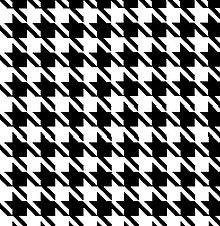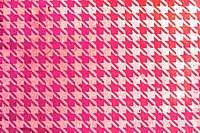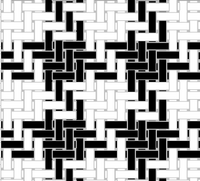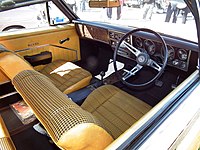Houndstooth

Houndstooth is a pattern of alternating light and dark checks used on fabric. It is also known as hounds tooth check, hound's tooth (and similar spellings), dogstooth, dogtooth or dog's tooth. The duotone pattern is characterized by a tessellation of light and dark solid checks alternating with light-and-dark diagonally-striped checks—similar in pattern to gingham plaid but with diagonally-striped squares in place of gingham's blended-tone squares. Traditionally, houndstooth uses black and white, although other contrasting colour combinations may be used.
History
[edit]The oldest Bronze Age houndstooth textiles found so far are from the Hallstatt Celtic Salt Mine, Austria, 1500-1200 BC.[1] One of the best known early occurrence of houndstooth is the Gerum Cloak,[2] a garment uncovered in a Swedish peat bog, dated to between 360 and 100 BC.[3] Contemporary houndstooth checks may have originated as a pattern in woven tweed cloth from the Scottish Lowlands,[4] but are now used in many other woven fabric aside from wool. The traditional houndstooth check is made with alternating bands of four dark and four light threads in both warp and weft/filling woven in a simple 2:2 twill, two over/two under the warp, advancing one thread each pass. In an early reference to houndstooth, De Pinna, a New York City–based men's and women's high-end clothier founded in 1885, included houndstooth checks along with gun club checks and Scotch plaids as part of its 1933 spring men's suits collection.[5] The actual term houndstooth for the pattern is not recorded before 1936.[6]
Oversized houndstooth patterns were also employed prominently at Alexander McQueen's Fall 2009 Collection, entitled Horn of Plenty.[7] The patterns were a reference to Christian Dior's signature tweed suits.[8]
Houndstooth patterns, especially black-and-white houndstooth, have long been associated regionally with the University of Alabama (UA). This is because the longtime UA football coach Paul "Bear" Bryant often (though not exclusively) wore black-and-white houndstooth fedoras.[9] The university has attempted to assert a trademark for houndstooth, especially when used in conjunction with other symbols of the school and its football team, a legal strategy that has been largely unsuccessful.[10][11]
The Australian department store David Jones's branding—a black-on-white houndstooth pattern—is one of the most recognised corporate identities in Australia. A government-sponsored panel judged it in 2006 as one of Australia's top-10 favourite trademarks.[12] The iconic design was the result of a 1967 rebranding exercise by chairman Charles Lloyd Jones, Jr., who wished that the store would be so well known by the design as to not require the use of the name on the packing. It was allegedly inspired by the houndstooth design on a Miss Dior perfume bottle of his mother's, Hannah Jones.[13] On 25 July 2016, David Jones' introduced a new logo, with a revised font style and removed references to the houndstooth online.
Variations
[edit]A smaller-scale version of the pattern can be referred to as puppytooth.[14]
In Pop-Culture
[edit]Ricky, from the popular Canadian comedy franchise "The Trailer Park Boys", can often be seen wearing a houndstooth button up shirt. It has become an unofficial branding element for the series, with different merchandise featuring the pattern.[citation needed]
Gallery
[edit]-
Red and white houndstooth pattern
-
A colored houndstooth dress
-
Weaving a small-scale houndstooth check in a 2:2 twill
-
A car interior with houndstooth pattern upholstery
-
A single element of the pattern
See also
[edit]References
[edit]- ^ "Archived copy" (PDF). Archived (PDF) from the original on 2022-04-07. Retrieved 2022-03-22.
{{cite web}}: CS1 maint: archived copy as title (link) - ^ "Gerumsmanteln-Färganalys - Historiska Museet". historiska.se. Archived from the original on 2018-03-06. Retrieved 2017-07-05.
- ^ "Sveriges äldsta bevarade klädesplagg - Historiska Museet". historiska.se. Archived from the original on 2018-03-06. Retrieved 2017-07-05.
- ^ Dunbar, John Telfer: The Costume of Scotland, London: Batsford, 1984, ISBN 0-7134-2534-2, 1984 (paperback 1989, ISBN 0-7134-2535-0)
- ^ "Gun Club Checks". The New Yorker. Vol. 9. New Yorker Magazine, Inc. 1933. p. 28. OCLC 1760231. Archived from the original on February 23, 2023. Retrieved October 9, 2011.
- ^ "Houndstooth". Dictionary. Merriam-Webster. Archived from the original on 9 February 2020. Retrieved 3 September 2019.
- ^ Eric Wilson (11 March 2009). "McQueen Leaves Fashion in Ruins". New York Times. Archived from the original on 14 March 2017. Retrieved 2 November 2015.
- ^ Sarah Mower (10 March 2009). "Fall 2009 Ready-to-Wear Alexander McQueen". Vogue. Archived from the original on 12 June 2017. Retrieved 2 November 2015.
The clothes were, for the most part, high-drama satires of twentieth-century landmark fashion: parodies of Christian Dior houndstooth New Look and Chanel tweed suits [...]
- ^ University of Alabama Supply Store. "Houndstooth, the Bear, and the University of Alabama". University Supply Store. Archived from the original on January 9, 2021. Retrieved January 7, 2021.
- ^ Jon Solomon (November 13, 2013). "Who has a right to use houndstooth? University of Alabama fights, even without a trademark". Alabama Media Group. Archived from the original on November 12, 2020. Retrieved November 12, 2020.
- ^ Kent Faulk (March 9, 2016). "Trademark board tosses Alabama houndstooth opinion but fight may continue". Alabama Media Group. Archived from the original on November 24, 2020. Retrieved November 12, 2020.
- ^ "IP Australia - Trademarks Centenary 2006". Australian Government. 2006. Archived from the original on 24 July 2008. Retrieved 18 August 2008.
- ^ McGinness, Mark (17 July 2010). "Name synonymous with DJs". The Age. Archived from the original on 4 December 2013. Retrieved 10 June 2013.
- ^ "Style hints & tips, everything a gentlemen needs to know about style - Charles Tyrwhitt". www.ctshirts.co.uk. Archived from the original on 2014-09-10. Retrieved 2011-09-18.





